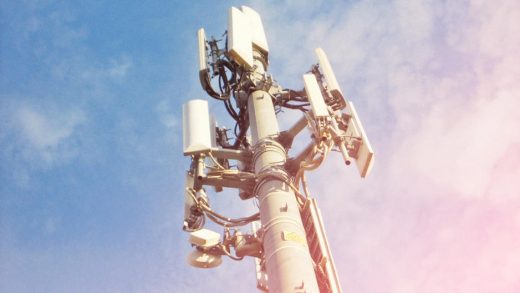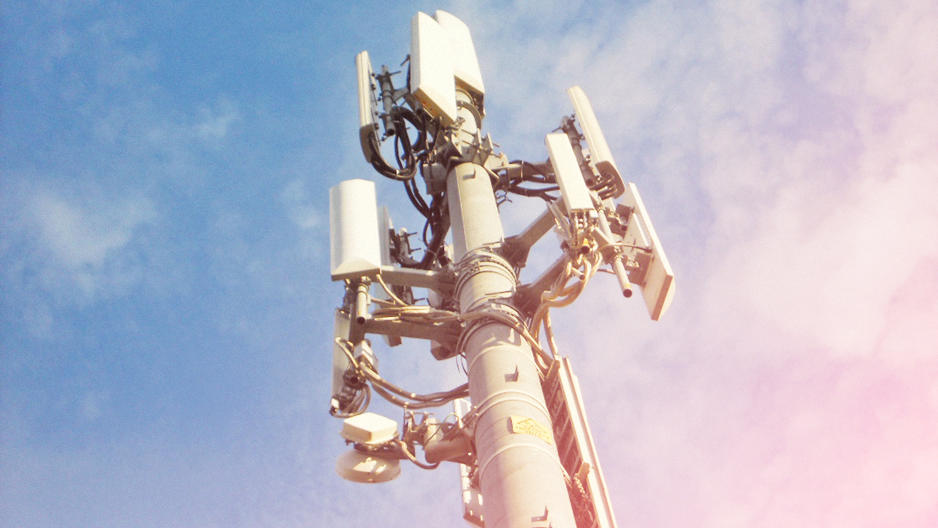The Wild Technology That Will Make 5G Wireless Work
Wireless technology is a stone soup of acronyms, jargon, numbers, and marketing gibberish that the industry likes to boil down into terms like “4G,” the technology used by today’s phones. (It’s also known as LTE, which stands for “long-term evolution”—as if that clarifies anything.) Now tech companies are talking about 5G, and Qualcomm has announced its first 5G modem chip, the Snapdragon X50, for phones and other gadgets. No surprise: 5G will be faster than 4G. But it will also bring tens or even hundreds of billions of new devices online.
Yes, the new standard will download apps and web pages way faster, and allow higher-resolution video streaming that doesn’t stutter. But it could also create a whole new connected world. Realistic scenarios include fleets of delivery drones flying in formation, tens of billions of wireless sensors constantly measuring every aspect of our planet, and a doctor on one side of the planet controlling a robotic scalpel on a patient on the other side. It could also finally kill landline broadband, cutting one more cord into the house or office.
This isn’t just speculation about future scenarios; some of it’s already happening. “5G is still based on LTE concepts,” says Akshay Sharma, who tracks wireless tech for research firm Gartner. Many tricks that engineers are doing with 4G/LTE, like loading phones up with extra antennas to goose speed, will be the foundation of 5G.

“New technology is essentially a gradient, a consolidation of many steps on the old technology,” says Serge Willenegger, an engineer and SVP for product management at Qualcomm. (His name is on over 50 wireless tech patents.) The Snapdragon X50 modem includes the new 5G technologies Willenegger and others are developing.
Your next phone—and maybe even the phone or two after that—is unlikely to be a 5G model. The X50 modem uses a flavor of the technology that’s Qualcomm’s best guess at what the open, international standard will be like once it’s finalized sometime in 2018. “It’s part of the process to build up the ecosystem,” Willenegger says. “Ultimately you don’t know everything until you put it to the test, start playing with it in the field.” It’s close enough, the company thinks, for gadget makers and wireless carriers to start trying out the technology by the second half of 2017.
If all goes as Qualcomm hopes, its chips might go into final products in 2018. 5G probably won’t get a wide rollout until 2019 or later, although South Korea is hoping to show off a 5G network during the 2018 Winter Olympics. Of course, Qualcomm will face stiff competition from other chipmakers, such as Intel and Samsung; and it may not have correctly anticipated the final standard. Intel, for its part, is instead providing reprogrammable chips for 5G trials and prototypes. It’s waiting before it commits to a chip design, which it told us will be “available to coincide with 5G mobile network deployments.”
The complex jiggering of physics principles, government regulations, and corporate interests to enable 5G will remake not just what people can do but how business gets done. The challenges facing nascent 5G technologies even hint at the problems that 6G may someday have to solve.
More Than Just Another G
If you’ve heard anything about 5G, it’s probably the speed figures. Today’s best 4G tech, LTE Advanced, is advertised at 225 megabits per second for downloads, and up to one gigabit per second in technology demonstrations. That’s pretty astounding, especially since LTE started at a top speed of about 12Mbps back in 2010. A lot of work has been done since then, and 5G codifies and expands those advancements, promising over 10 Gbps.
What will be the upshot of all that speed? We don’t yet know. “Two things will happen for sure,” says Willenegger. “Those advanced capabilities will be used, and they will be used in ways that are different than we envision.” Consider that work on 4G started a dozen years ago. “In November 2004 there was a workshop on what should be in 4G,” says Durga Prasad Malladi, the senior VP for engineering at Qualcomm, who has a whopping 233 patents. “Serge and I were there. I remember, it was Election Day.” Since then, George W. Bush won a second presidential term, an unknown named Barack Obama shot to fame and served two terms, and we’re nearing the end of an unfathomable race to pick his successor. Talk about an unforeseeable future.
That first 4G workshop was over two years before Apple announced the iPhone and thereby kicked off a smartphone revolution that encompasses tablets, drones, smart watches, fitness trackers, virtual reality, Snapchat, Tinder, and Pokémon Go. Work on 4G started before most people had 3G (which the first iPhone didn’t support), when just getting email on a phone was a big deal.
But 5G offers another kind of speed that may be even more important: A speedy response time. Every network has latency—the lag between when you do something, like ping a web site, and when the signal arrives. Today, the latency is measured in dozens of milliseconds. Testing firm OpenSignal found Sprint to have the lowest 4G latency in the U.S., at 66ms; AT&T was highest, at 85ms. That’s fine for voice calls: any lag under 100ms is considered imperceptible. But it’s downright languid for some near-future scenarios. For instance, carmakers and trucking companies are already envisioning autonomous convoys that share information, like when the lead vehicle needs to slow down, so they can drive in tight formation.
Using smaller data packets and faster processing (thanks to Moore’s Law), 5G aims to have a typical latency of just 5ms, and get it down to less than 1ms—essentially instantaneous—when needed. There are some technical downsides to doing this for every bit of wireless data, but 5G networks will be able to turn on low latency when required. A fleet of Amazon drones, for instance, might get into trouble flying over a congested city if there’s a delay involving dozens of milliseconds.
The full name for this tech is “ultra-reliable low latency communication.” How reliable? As low as a one per billion error rate—safe enough for a surgeon to control instruments over the internet. “Of course we’re a long way from that,” says Malladi. “But if you have the capability, can you do it? Yeah.”
Though known for its ability to move huge amounts of data very quickly, 5G is also designed for new gadgets that move just a few bits, rather slowly—environmental and other sensors. Cheap cloud networks and powerful artificial intelligence are creating an insatiable appetite for sensor data that companies can munch, crunch, and learn from.
Some sensors, like the ones on planes and factory machines, will collect and stream oodles of data. But others, like soil moisture sensors on farms or connected water meters that report usage to the utility, might just send a blip every hour or less. Today, networks go through a big setup process to establish a connection between gadgets. That’s important for the reliability of a phone call or a video stream (and certainly for drone fleets or robotic surgery). It’s overkill for occasionally tossing a few digits from a sensor to the network—such overkill that it would overwhelm networks on a planet featuring hundreds of billions of sensors, as some futurists foresee.
5G uses something called “connectionless access” that requires much less network chatter. “We literally just say, here’s a packet of data, here’s a radio channel, just shoot it across…and we’ll catch it,” says Jason Elliott, the 5G market development manager for Nokia. (The company no longer makes phones, but continues to sell a lot of network hardware.) He likens connectionless access to tossing a ball to your friend, rather than first putting the ball in a tray and then passing over the tray.
The Great Spectrum Chase
The speed of light being a constant, wireless engineers have still found ways to make networks faster, with tricks like more efficient algorithms and more powerful chips to encode and decode signals. But the real boost in 5G comes from carrier aggregation—using several wireless signals at once, like a band of 700MHz and a band of 1900MHz spectrum. A simple analogy would be adding more lanes to a freeway, but it’s more like combining lanes from several different freeways that may be miles apart. “It’s about aggregating all the radio assets you can find so you can deliver the highest possible rate,” says Willenegger.
The process has already started with 4G, with phones combining any two of 20 or more possible bands to download pieces of a huge videogame or upload bits of a HD Snapchat video. 5G wants to do a lot more of that. Where the iPhone 7 has two antennas, and the Samsung Galaxy S7 has four, their 5G successors might have 36 or more, all fitting on a chip the size of a dime.

Like opening up the western frontier, governments and corporations are opening a lot more wireless frequencies, 11GHz, for 5G—more spectrum than is currently used for all wireless data service on Earth. (The bulk of this is at frequencies of 20GHz and higher, often called “millimeter-wave.”) This plentiful spectrum also allows much wider wireless channels to pack more data: 800 MHz wide, vs. 60 MHz wide for 4G.
There’s a reason why no one’s done this before. “This spectrum is horrible spectrum,” says Willenegger. “The laws of physics are against us,” adds Malladi. The two have been working together for more than 15 years on 3G, 4G, and now 5G technologies; and they often finish each other’s sentences.
Short-wavelength signals don’t travel very far, and they bounce all over the place. “If you hold your phone the wrong way, maybe you lose your coverage completely,” says Malladi. Willenegger chuckles and recalls Steve Jobs’s famous “Just avoid holding it in that way,” admonition to iPhone 4 owners who lost reception due to bad antenna placement.
When things move around, the wireless system has to continually track where gadgets are going. That takes a lot of transmitters. Forget towers: We’re talking iPad Mini-size boxes all around buildings and streets. The more obstacles, the more you need. Both the cells and the mobile devices direct the signals—a process called “beamforming”—even bouncing them around corners. That’s one of the reasons they need so many antennas: It takes an array of them, interacting with each other, to steer a beam. This is really hard physics.

“Why are you going there? It’s self-inflicted pain,” says Willenegger. “The reason to go there is resources. There’s oil, but the cost of drilling is increasing,” he says, adopting an energy-industry metaphor. “We’re fracking now,” adds Malladi.
They are drilling in other places too, like the frequencies used for Wi-Fi, which runs on frequencies around 2.4GHz and 5GHz. Most Wi-Fi networks stick with the lower frequency, leaving lots of capacity around 5GHz. 5G devices might use this for cellular signals, or they might just piggyback on Wi-Fi for extra capacity, since some phone companies also run public Wi-Fi networks. Or they might do both.
The Network Is An App
Dynamically juggling frequency bands and wireless standards—or trading off latency, accuracy, and expediency—requires a very different kind of network than has existed up to 4G. It’s a move from pieces of hardware with specific duties to what’s called a “software-defined network.” “It’s not about buying a specific box to do a function,” says Elliott. “It’s about having a datacenter with a rack of servers, and you could deploy the different functions on those servers.” (As with many things 5G, software-defined networks are already emerging in 4G systems.) Intel is not only hoping to sell a lot of modem chips for 5G gadgets, for instance. It’s hoping to sell CPUs, RAM, and solid state hard drives for servers.
Software-defined networks still have a lot of hardware aspects. There are physical routers, for example, but they can be reconfigured on the fly to widen or narrow the connections between them in response to what the network needs.
A reprogrammable network will become even more important as 5G starts running out of capacity, which will happen. One idea for dealing with that eventuality is to share airwaves so that, for instance, if a Verizon phone isn’t using a frequency for a few milliseconds, an AT&T one can sneak a few packets through. This could create up to a 1000-fold increase in bandwidth, says the U.S. military, which is sponsoring a contest for engineers to develop these spectrum-sharing technologies. “I think the entire industry, including academia, is looking at that one,” says Malladi.
Willenegger jokes that spectrum sharing might be in the 6G standard. But then he considers and says that new technologies will definitely get added onto 5G, until it accumulates so many changes that it’s time to create a 6G. Spectrum sharing might be one of those additions. “There will be 5G+, 5G Advanced, 5G Turbo, whatever the increment,” says Willenegger. “Some will say there will never be a 6G because we’ve done everything we can imagine.”
“We wouldn’t say that,” adds Malladi.
Fast Company , Read Full Story
(51)














